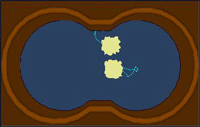
The above image is just an animated gif file. Click the above button or this link to launch this interactive activity.
| In 1827, using a microscope, the botanist Robert Brown observed that pieces of pollen grains suspended in water moved in random directions. Initially, people thought Brown had discovered the essence of life. However, after several other experiments, it was apparent that any tiny particles floating in water would move in this way, even microscopic pieces of dust. In this activity you will use a virtual microscope which is focused on a tiny particle floating in water. When you run that model, you will see the behavior that Brown observed and what is now known as Brownian Motion. |

The above image is just an animated gif file. Click the above button or this link to launch this interactive activity. |
| System requirements: You must have Java Version 5 or higher in order to run this program. Please go to java.com to get the latest Java software, if you are not sure. |
| Failed? Check out the FAQ for troubleshooting. |